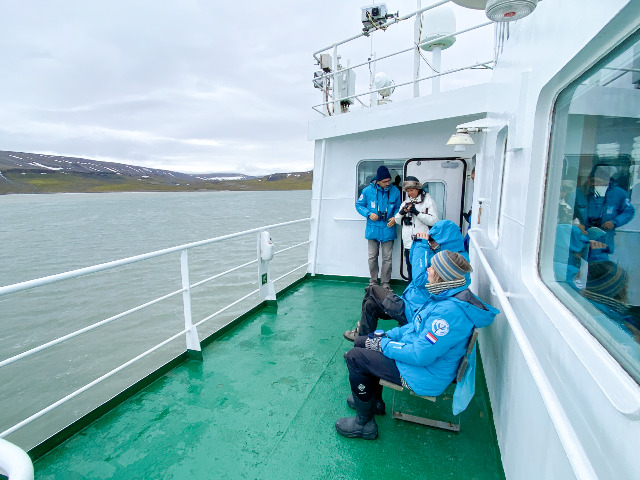SEES expedition: Good-bye, coal harbour!
| Datum: | 18 juli 2022 |
| Auteur: | Zdenka Sokolíčková |

16 July 2022
Good-bye, coal harbour! Participative science, here we come! On Wednesday 13 July 2022, after two years when the expedition was postponed due to the pandemic and almost ruined last minute by the strike of Scandinavian Airlines, the blue-and-white expedition vessel Ortelius sailed out of Longyearbyen harbour. The passengers form a unique „ecosystem“; almost 60 researchers from a wide range of disciplines mingle with about 30 science supporters partaking in the Arctic Academy, but also with journalists, policy makers and science managers. Experienced guides, crew and expedition leaders back up the endeavour. Collective excitement mixes with first signs of seasickness while heading to the south; on Day 2, we hope to reach Kapp Lee and Edgeøya.
The span of research projects carried out on board and the variety of methods is overwhelming. People measure air pollution and black carbon, take water samples both from the ocean and fresh water, study vegetation and food chains of fish and large mammals, count birds, collect sea weed, investigate archeological sites, reconstruct history, observe human interaction, and more. Among the Arctic Academy participants, there are many with scientific background and all with genuine interest in science, eager to get involved. When the fog thickens and it becomes clear that the whole Thursday will be spent on board, both due to polar bear safety and a strong swell making landing with the zodiac impossible, the passengers of Ortelius bear it with patience. This is how it works on polar expeditions - you plan and prepare the best you can, and then you take it as it comes.
Friday is the day of being on alert. We wait, become excited, get ready, and then hear from the expedition leader about alternative plans of where to land and what to do there as the previous plan does had not worked out. The ice retreated fast this year, many polar bears got „stuck“ in the area and we don’t want to put these magnificent animals at risk through our intervention. Science talks given by researchers help us learn about each others’ work, but longing for what is „out there“ is palpable. When the news comes that neither Barentsøya nor Edgeøya are suitable for landing today, Ortelius takes us to the East Coast and we stop in front of Negribreen. And here we are, admiring myriads of colours (How could I ever think ice was white?!) the sunshine displays on the icebergs and the monumental glacier front, listening to the bubbles captured for ages in the ice and now making a sweet cracking sound when reaching the water surface. Nobody is „doing science“, we are present in the moment, encountering an entity that takes our breath and leaves an unforgettable memory. Hopeful, we fall asleep while Ortelius heads back to Edgeøya.
And indeed, there are no polar bears at the landing site, the sky has cleared up, the wind is merciful and off it goes: seven groups land with zodiacs in the delta of Rosenbergdalen. Some pick plastic litter, some go on a hike, some go hunting for ancient antlers, and a group of researchers interested in soil and vegetation crosses the river, they pour water out of their rubber boots and proceed further into the valley to revisit old plots, sample moss, lichen and mushrooms. What a rush! What an excitement! Unsurprisingly, the news about a polar bear walking towards us and thus the need to retreat back to Ortelius is met with a deep sigh, but we managed to get some work done within the several hours of concentrated but also joyful scientific activity. Not everybody got to carry on their research yet, but Rosenbergdalen was a success. We wave farewell to the polar bear sniffing on the shore, the fog embraces us again and we share impressions with each other, ready for what comes next.
Over de auteur
Zdenka is post-doc at the Arctic Centre working for the Svalur project

